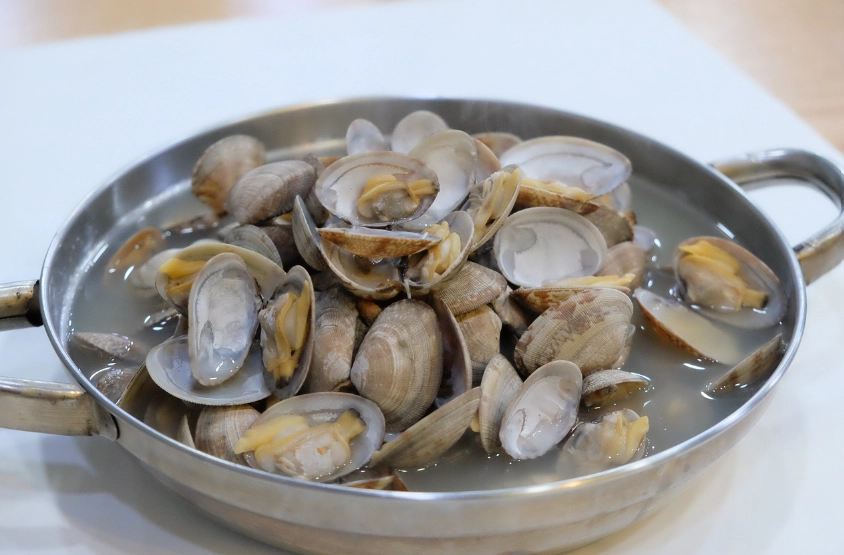Introduction to Clam Recipes
Clam Recipes, those intriguing bivalve creatures residing beneath the ocean’s surface, have long captured the imagination of seafood enthusiasts and marine biologists alike. These marvelous mollusks, with their sturdy shells and tender flesh, play a vital role in both aquatic ecosystems and culinary traditions around the globe.
From the sandy shores of New England to the bustling fish markets of Asia, clams have carved out a special place in the hearts (and stomachs) of people everywhere. But before we delve into the depths of clam culture, let’s take a moment to understand the basics of these extraordinary creatures.
Types and Varieties of Clam Recipes
Common Types of Clams
Littleneck Clams: These petite bivalves, named for their small size and distinct hinge, are prized for their sweet and tender meat. Found along the Atlantic coast of North America, littlenecks are often enjoyed raw on the half shell or steamed with garlic and butter.
Quahogs: Also known as hard-shell clams, quahogs are revered for their robust flavor and sturdy shells. These hefty mollusks, native to the waters of the northeastern United States, are frequently used in clam chowder and other hearty dishes.
Manila Clams: Hailing from the Pacific Northwest, Manila clams are celebrated for their delicate texture and briny taste. These versatile shellfish can be steamed, sautéed, or incorporated into pasta dishes for a taste of the sea.
Regional Varieties
Across the globe, different regions have their own unique varieties of clams*, each with its own distinctive flavor profile and culinary uses. Let’s take a closer look at some of these regional delicacies.*
Geoduck Clams: Native to the Pacific Northwest, geoduck clams are famed for their unusually long siphons and sweet, crunchy meat. These oversized bivalves are often enjoyed raw in sushi or ceviche for a true taste of the ocean.
Blood Clams: Popular in Southeast Asian cuisine, blood clams are prized for their rich, iron-infused flavor and vibrant red color. These unique shellfish are typically eaten raw or lightly cooked to preserve their delicate taste and texture.
Surf Clams: Found along the sandy shores of the Atlantic coast, surf clams are known for their large size and firm, meaty flesh. These hearty bivalves are commonly used in seafood stews, fritters, and other hearty dishes for a taste of coastal comfort.
Harvesting and Sustainability Clam Recipes
Harvesting Methods
The process of harvesting clams* is as diverse as the species themselves. From handpicking along the shoreline to dredging in deeper waters, there are various methods used to gather these prized shellfish. Let’s explore some of the most common harvesting techniques.*
Hand Harvesting: In shallow coastal waters, clam harvesters often use rakes or shovels to handpick clams from the sandy seabed. This method is labor-intensive but allows for greater selectivity and minimal environmental impact.
Dredging: In deeper offshore waters, mechanical dredges are sometimes used to harvest large quantities of clams quickly. These heavy-duty devices are dragged along the ocean floor, scooping up clams along with other sediment. While efficient, dredging can disturb sensitive marine habitats and result in unintended bycatch.
Raking: Similar to hand harvesting, raking involves using specialized tools to comb through the substrate in search of clams. This method is commonly used in intertidal zones and estuaries where clams are abundant but may require permits and regulations to ensure sustainability.
Sustainability Practices
As demand for clams* continues to rise, it’s crucial to prioritize sustainable harvesting practices to ensure the long-term health of clam populations and marine ecosystems. Here are some key sustainability initiatives being implemented in the clam harvesting industry.*
Stock Assessments: Fisheries managers conduct regular assessments of clam populations to monitor their abundance and health. By tracking population trends and ecosystem dynamics, they can make informed decisions about harvest quotas and conservation measures.
Gear Restrictions: Regulations are in place to limit the use of destructive harvesting gear such as hydraulic dredges, which can damage sensitive habitats and disrupt marine life. By enforcing gear restrictions and seasonal closures, authorities can protect critical clam habitats and reduce ecological impacts.
Aquaculture: The cultivation of clams through aquaculture offers a sustainable alternative to wild harvesting. By raising clams in controlled environments such as coastal farms and hatcheries, growers can minimize environmental impacts, reduce pressure on wild stocks, and ensure a steady supply of high-quality seafood.
Clams Casino
Ingredients Clam Recipes
- 24 littleneck clams, scrubbed clean
- 6 slices bacon, diced
- 1/2 cup breadcrumbs
- 2 cloves garlic, minced
- 2 tablespoons grated Parmesan cheese
- 2 tablespoons chopped fresh parsley
- 1/4 cup white wine
- Lemon wedges, for serving
Instructions:
- Preheat your oven to 425°F (220°C). Arrange the clams on a baking sheet.
- In a skillet, cook the diced bacon over medium heat until crispy. Remove the bacon from the skillet and set aside.
- In the same skillet, add the breadcrumbs and garlic. Cook until the breadcrumbs are golden brown and toasted.
- Remove the skillet from the heat and stir in the cooked bacon, Parmesan cheese, and parsley.
- Spoon the breadcrumb mixture onto each clam, pressing lightly to adhere.
- Drizzle the white wine over the clams.
- Bake in the preheated oven for 10-12 minutes, or until the clams are cooked through and the breadcrumbs are golden brown.
- Serve hot with lemon wedges on the side.
Clam Linguine with White Wine Sauce
Ingredients:
- 1 pound linguine pasta
- 2 tablespoons olive oil
- 4 cloves garlic, minced
- 1 shallot, finely chopped
- 1/2 teaspoon red pepper flakes
- 1/2 cup white wine
- 24 littleneck clams, scrubbed clean
- 2 tablespoons chopped fresh parsley
- Salt and pepper, to taste
Instructions:
- Cook the linguine pasta according to the package instructions until al dente. Drain and set aside.
- In a large skillet, heat the olive oil over medium heat. Add the minced garlic, shallot, and red pepper flakes. Cook until fragrant, about 1 minute.
- Pour in the white wine and bring to a simmer.
- Add the clams to the skillet, cover, and cook for 5-7 minutes, or until the clams have opened.
- Discard any clams that do not open.
- Add the cooked linguine to the skillet with the clams and toss to coat in the sauce.
- Season with salt and pepper to taste.
- Garnish with chopped fresh parsley before serving.
FOR MORE RECIPES CLICK HER

